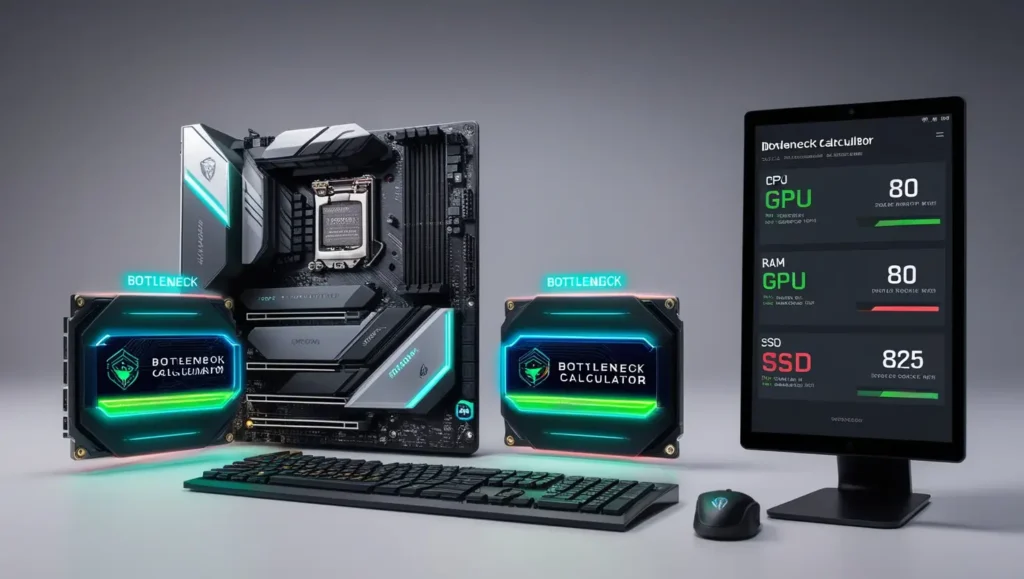Understanding CPU Bottleneck and PC Bottleneck: A Complete Guide

Introduction
Modern computers are powerful machines designed to handle multiple tasks simultaneously. However, even high-end systems can face performance issues when certain components limit the overall speed of the system. This performance limitation is commonly referred to as a bottleneck. Among the most discussed types are CPU bottlenecks and PC bottlenecks. Understanding what they are, how they occur, and how to fix them can help you optimize your system for gaming, productivity, and everyday use.
What is a Bottleneck in a PC?
A bottleneck occurs when one component in a computer system restricts the performance of the other components. Imagine water flowing through a bottle: the narrow neck limits how much water can pass through, regardless of how wide the rest of the bottle is. Similarly, if one part of your computer is significantly weaker than the others, it will limit the performance of the entire system.
For example, if you have a very powerful graphics card (GPU) but a low-end processor (CPU), your GPU may not reach its full potential because the CPU cannot keep up. On the other hand, if your CPU is extremely fast but your GPU is outdated, your games may still run slowly because the graphics card cannot render frames fast enough.
Bottlenecks are not always bad, but identifying and minimizing them helps achieve balanced performance.
Types of PC Bottlenecks
There are several kinds of bottlenecks, depending on which component causes the slowdown:
-
CPU Bottleneck – When the processor cannot keep up with the workload, causing the GPU or other parts to wait.
-
GPU Bottleneck – When the graphics card is too weak compared to the CPU.
-
RAM Bottleneck – When the system does not have enough memory or uses slow RAM.
-
Storage Bottleneck – When a slow hard drive or SSD delays data transfer, affecting loading times.
-
Network Bottleneck – When a slow internet connection limits online performance, especially in games or streaming.
Among these, CPU bottlenecks are particularly common in gaming and intensive multitasking environments.
What is a CPU Bottleneck?
A CPU bottleneck happens when the processor cannot process data fast enough to keep up with other components, especially the GPU. Since the CPU is responsible for handling logic, calculations, AI, and game instructions, if it is overloaded, it slows down the entire system.
For instance, in modern games, the GPU handles rendering the graphics, but the CPU must process game logic, player movements, NPC behaviors, and physics. If the CPU cannot send instructions to the GPU quickly enough, the GPU will remain underutilized, leading to lower frame rates and stuttering.
Common Signs of CPU Bottleneck
Recognizing a CPU bottleneck is essential for troubleshooting. Some common signs include:
-
Low GPU Usage: If your graphics card usage is significantly below 90–100% while gaming, but your CPU is at or near 100%, it’s likely a CPU bottleneck.
-
Frame Rate Drops in CPU-Heavy Scenes: Open-world games, cities with many NPCs, or scenes with lots of AI calculations may cause sudden drops in frame rates.
-
Stuttering or Lag: Even if the average frame rate seems fine, you might experience uneven frame pacing and stuttering.
-
Task Manager Indicators: High CPU utilization combined with low GPU utilization during intensive applications is a clear bottleneck sign.
Causes of CPU Bottlenecks
Several factors can lead to a CPU bottleneck:
-
Outdated or Low-End CPU
If the CPU is too old or weak compared to the GPU, it may not handle modern workloads efficiently. -
Running Background Processes
Excessive programs running in the background consume CPU resources, reducing the available power for games or heavy tasks. -
Poorly Optimized Software
Some games and applications rely heavily on single-core performance, and if your CPU has weaker single-threaded capability, bottlenecks can occur. -
Mismatch Between CPU and GPU
Pairing a high-end GPU (e.g., RTX 4080) with a mid-range CPU may lead to CPU bottlenecking in many games. -
Thermal Throttling
If the CPU overheats, it may automatically reduce its clock speed to prevent damage, leading to reduced performance.
How to Identify CPU Bottlenecks
You can detect CPU bottlenecks using a few simple methods:
-
In-Game Performance Monitoring: Many games have built-in performance overlays, or you can use software like MSI Afterburner to check CPU and GPU usage in real time.
-
Benchmarking Tools: Programs such as 3DMark or Cinebench help measure CPU performance compared to your system’s GPU.
-
Frame Time Graphs: Analyzing frame times can reveal stuttering patterns caused by CPU limitations.
If your CPU usage is maxed out while your GPU is not, it’s a strong indicator of a bottleneck.
How to Fix or Reduce CPU Bottlenecks
You don’t always need to upgrade your CPU immediately. Here are several strategies to reduce CPU bottlenecks:
-
Close Background Programs
Shutting down unnecessary apps frees up CPU resources for more demanding tasks. -
Optimize Game Settings
Lower CPU-intensive settings such as draw distance, shadows, or crowd density. Interestingly, increasing some GPU-heavy settings may shift the load from CPU to GPU, balancing performance. -
Enable Game Mode (Windows)
Game Mode can prioritize game processes, reducing interference from background tasks. -
Upgrade Your CPU
If your processor is genuinely underpowered, upgrading to a more capable CPU with more cores, threads, and higher clock speeds can make a significant difference. -
Overclocking
Carefully overclocking your CPU can provide extra performance, though it must be done with proper cooling and stability testing. -
Update Drivers and BIOS
Sometimes performance issues stem from outdated drivers or BIOS firmware. Keeping them updated can help.
Overall PC Bottleneck Considerations
A PC bottleneck is just one piece of the larger performance puzzle. A well-balanced system ensures that CPU, GPU, RAM, and storage work together efficiently. For example:
-
Pair a mid-range CPU with a mid-range GPU for balanced performance.
-
Ensure you have sufficient RAM (16 GB is a good standard for modern systems).
-
Use an SSD for faster load times and smoother performance.
-
Regularly maintain your system to avoid thermal issues and dust buildup.
Balancing components is more cost-effective than upgrading one part to a top-tier model while neglecting others.
Conclusion
Bottlenecks are an inevitable part of PC building and gaming, but understanding them allows you to optimize and upgrade smartly. A CPU bottleneck occurs when the processor limits the performance of other components, especially the GPU. By monitoring usage, adjusting settings, closing background processes, and upgrading when necessary, you can minimize bottlenecks and enjoy smoother performance.
For more information.
- Art
- Causes
- Crafts
- Dance
- Drinks
- Film
- Fitness
- Food
- Games
- Gardening
- Health
- Home
- Literature
- Music
- Networking
- Other
- Party
- Religion
- Shopping
- Sports
- Theater
- Wellness



